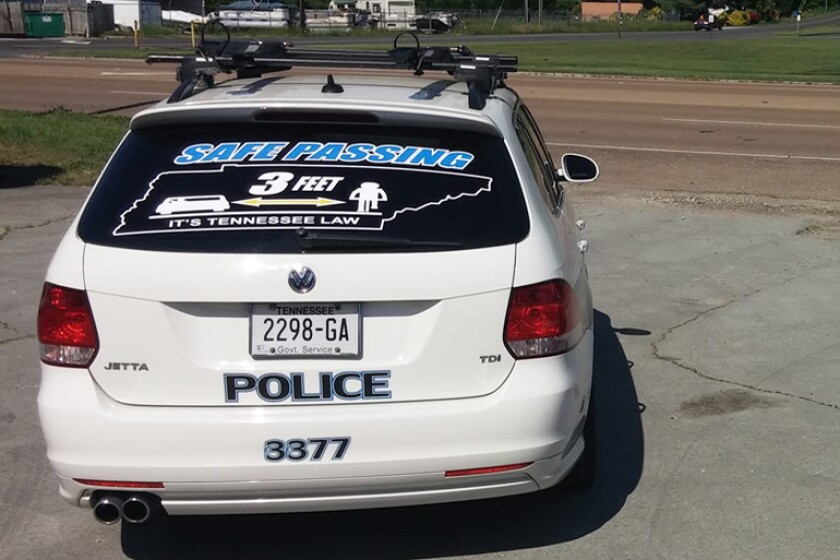Safe passing laws have seen dramatic growth in popularity over the past 20 years. In 1973, Wisconsin became the first state with such a law aimed at protecting bikers. All states have a safe passing law of some kind, but until the early 2000s, only three followed Wisconsin’s example of prescribing a specific distance for passing a bicyclist. Now, more than half do.
Bike advocates have pushed more states to pass the legislation, but they also say police rarely enforce the laws. Even worse, when police do issue citations, the lack of objective evidence can lead judges to throw them out.
“Anecdotally, it can get into a he-said-she-said issue,” explained Ken McCleod, a policy specialist from the League of American Bicyclists.
It’s difficult to know how often drivers avoid penalties because of insufficient evidence, but McCleod pointed to traffic citation data from the Florida Department of Highway Safety and Motor Vehicles. Last year, the state recorded 496 moving violations for improper passing of bicyclists. Of those, Florida courts dismissed about 36 percent of the citations. McCleod said he thinks video evidence would result in fewer dismissals both in Florida and around the country.
MORE: This appears in the free Technology e-newsletter. Subscribe here.
Up until a year ago, Chattanooga police had never enforced the safe passing law -- even though it had been on the books since 2007. In general, the laws present practical challenges to police. An officer on a bike isn’t likely to catch a driver who just violated the law. Instead, police have to employ sting operations, coordinating between an officer on a bike and patrol cars ready to pull over the offending drivers.
Chattanooga Police Chief Fred Fletcher -- who has placed new emphasis on enforcing the law -- came to the department after serving as a police liaison to the cycling community in Austin, Texas, where officers get training on how to eyeball a three-foot violation.* A good rule of thumb, Fletcher said, is to gauge whether the officer on a bike can reach out and touch the car; if so, it’s closer than three feet.
Despite being a big believer in the training, Fletcher wanted to try new equipment that would improve officers’ ability to identify violations. He knew an Austin-based software firm called Codaxus was developing a device to support safe passing laws.

The device uses an ultrasound detector to measure the distance between a car and a cyclist. (Codaxus)
“You can obviously tell the difference between 36 inches and 10 inches,” said Chris Stanton, a co-founder of Codaxus. But the margin between two feet and three feet is more subtle, especially when cars are moving quickly. Technology can provide a more precise measurement, Stanton said.
The Codaxus device uses an ultrasound detector to measure the distance between the car and the cyclist. A separate camera attached to the handlebars of the bike records a reading of the distance as well as the license plate and model of the vehicle. In Chattanooga, judges have agreed to consider the video archives as evidence of motorists violating the law.
The experiment in Chattanooga is small in scale so far. One officer on one bike is using the equipment. Since late May, police have stopped about 25 drivers for violating the law. So far, no one has gotten a citation, but if they do, judges have agreed to mandate bike safety classes in lieu of fines. If someone refuses to take the class, however, they could face a maximum fine of $50. In most cases, officers try to use the technology to educate motorists about the law, even going so far as replaying the video to show how the close encounter feels from a biker’s perspective.
“We’re trying to increase empathy and understanding,” Fletcher said. “It’s clear that very few people are intentionally putting people at risk.”
The department is trying to raise awareness about the law through marketing too. Some police vehicles have signs on windows that diagram the required distance between vehicles and bikes.

A police vehicle with signs on windows that diagram the required distance between cars and bikes (Chattanooga Police Department)
While Chattanooga is the only jurisdiction using the device, Stanton said municipalities in more than a dozen states -- including Texas, Kentucky and Florida -- have contacted him about trying the technology. Fletcher praised the technology, but said he didn’t think every police department should rush out to buy it. Instead, departments should start by training officers to recognize violations and then dedicating resources to show drivers that police are serious about enforcing the law.
If more police departments do get the detectors, officers should use discretion in how they use them to enforce safe passing laws, said Ernest Ezis, a bike safety advocate in Boulder, Colo. Ezis supports the idea of documenting aggressive drivers and trying to change their behavior. (He maintains a website that allows cyclists to report dangerous motorists.) Nevertheless, the precision of the system creates the potential for unnecessary citations. A driver who barely violates the buffer -- getting a reading of 34 inches, for example -- is the wrong target, he said.
"I'd prefer to see real enforcement against dangerous drivers."
*CORRECTION: A previous version of this story described Chief Fletcher as a former chairman of the Austin Bicycle Advisory Council. He was the Austin Police Department's liaison to the bicycle community.








